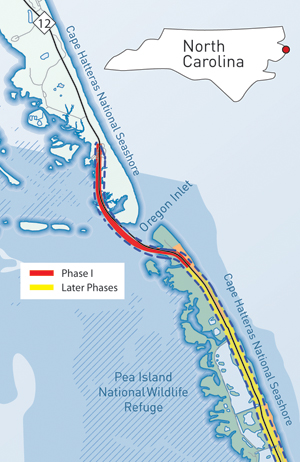

The Herbert C. Bonner Bridge on North Carolina's Outer Banks has reopened after the discovery of excess scour around underwater pilings forced a two-week closure. The closure isolated more than 4,000 full-time residents on Hatteras Island and added fuel to the long-simmering debate over replacing the half-century-old, 2.5-mile structure spanning Oregon Inlet.
Because of the highly volatile and dynamic nature of the inlet's currents between the Atlantic Ocean and Pamlico Sound, the North Carolina Dept. of Transportation has kept close watch on the 260-span prestressed-concrete girder bridge's underwater supports through a regular program of weekly and post-storm-event sonar scans, intermittent dives and deck movement monitoring.
In mid-November, routine sonar scanning revealed that erosion at Bent 166, near the bridge's southern end, was accelerating, with sand surrounding nine of the bent's 10 piles as much as seven ft below the critical level of 20 ft.
"We have had multiple scour protection projects in place that have been successful in reducing and minimizing scour at pilings along the bridge," says NCDOT spokeswoman Jennifer Garifo. While several adjacent bents underwent less extensive scour repairs in 2011, "at this particular location, there was no protection in place to prevent such a thing from happening."
The agency was already contracting for scour repairs when NCDOT engineers determined the rate of erosion posed an imminent safety risk. North Carolina Secretary of Transportation Tony Tata ordered the bridge closed on Dec. 3 and declared a state of emergency, allowing the agency to suspend normal contract bidding procedures.
With emergency ferry service established to preserve access to the island, NCDOT contracted with Oak Brook, Ill.-based Great Lakes Dredge and Dock Co., which was already conducting dredging operations nearby, to transfer sand from Oregon Inlet's main navigation channel to the troubled bent. Over two days, the dredge "Alaska" pumped approximately 30,000 cu yd of sand to the scoured area, adding 15 ft to 20 ft of material around the pilings.
Permanent Repair Sought
Follow-up sonar scans, two test pilings and diver inspections confirmed that a sufficient amount of dredged sand had settled in place to stabilize the bent, thus allowing a Dec. 15 bridge reopening.
NCDOT also awarded a $1.6-million, 90-day contract to Carolina Bridge Co. Inc. to implement a permanent repair strategy based on a ring of interconnected, 4-ft-tall concrete armor units from Contech Engineered Solutions, called A-jacks, to be placed around the bent, with each unit's interior being filled with 4-ft by 4-ft sandbags.
An additional two layers of A-jacks and sandbags will be placed atop the base layer for a total of 10 ft to 12 ft of protection. Along with stabilizing the newly pumped sand around the pilings, the structure will allow sand to collect over the sandbags and A-Jacks, providing additional support.















